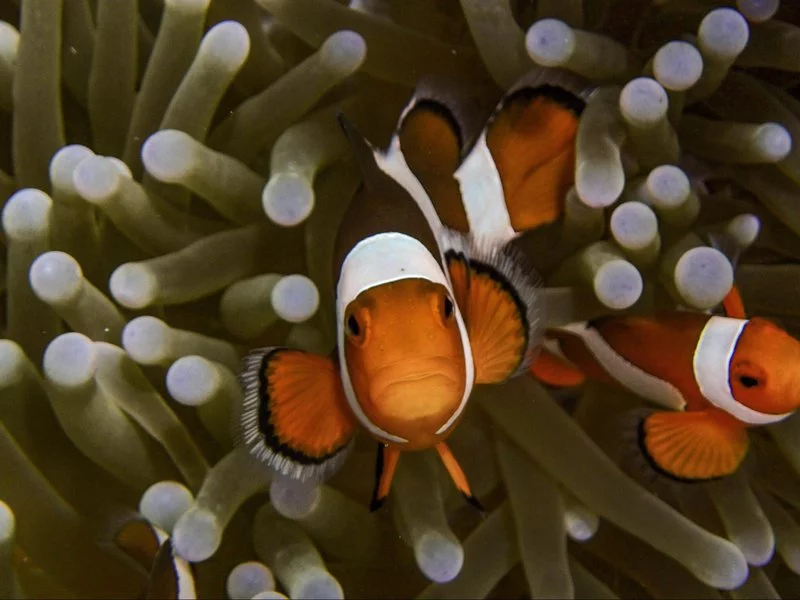Some of the most familiar faces up and down the whole 2000km of the Great Barrier Reef are those
of the anemone fish, or as they are better known, the clown fish. The 2003 “Finding Nemo” thrust
these little guys into the limelight and they have been on everyone's bucket list to see on
their tropical reef adventures. The name clown fish is synonymous with the orange and white
striped visages of Marlin and Nemo, but did you know there are 28 different species of clownfish
(anemone fish) that all look a bit different?
The anemone fish belong to a larger group of fish called Damsel fish. The anemone fish are set
apart from the other fish in this group due to the symbiotic relationships they have with various
species of anemone. Now for those of you who don’t know, an anemone is actually an animal closely
related to jellyfish and just like their jellyfish cousins, anemones also have stinging cells
called nematocysts on their tentacles. These stinging cells serve to protect the anemone from any
potential predators. The relationship between anemones and the anemone fish are mutually
beneficial which means both parties get something good out of hanging out together. The anemone
fish get a safe place to live and raise young amongst the tentacles of the anemone and in turn
the anemone gets a very good house guest. The fish clean the anemone and keep it free from
parasites, chase away anyone who may want to nibble on the anemone, most likely a cheeky
butterfly fish, and also provide the anemone with nutrients from their own waste.
By now you are probably all thinking “but how does the clownfish put up with the anemone sting ?”. Well a lot of anemone fish species are born with a mucus coat over their skin which is much thicker than normal, this mucus layer is thick enough to protect them from the anemones stings. Other species have to acquire their protection, this means that they have to brave the sting rub themselves up against the anemones tentacles. This transfers the anemones mucus and chemical signatures into the fish’s own mucus layer and it eventually builds up enough protection to be immune to the sting. Even species born with the thick protective layer rub themselves against their anemones tentacles. It is thought that they do this because the chemical substances the fish get on their skin from the anemone eventually build up to the point where the anemone recognises the fish as part of its own body and no longer triggers its stinging cells.
Another interesting thing about anemone fish is that they are all hatched as male, so how do they get females then? Well in anemone fish schools there is always one large dominant fish which is the female, who is also the most aggressive , there is then a smaller dominant male, these two fish are the only reproducing fish in the school, the rest are all juvenile males. When the dominant female dies the larger male will undergo a sex change and become the new dominant female fish, the rest of the younger males then move up the ranks. Their ability to change sex in this way means that anemone fish are known as sequential hermaphrodites, they start life as one sex and mature into the other. It sounds pretty weird to us but there is actually a large proportion of fish species who are hermaphrodites so it is considered quite normal in the fish world.
The anemone fish in the Whitsundays are some of our favourite little fishy mates at
Wings Sailing Charters Whitsundays. We love them so much that our crew have memorised where the little guys and their anemones have set up their home on the reef. We visit them all the time when we snorkel in the
Great Barrier Reef and the
Whitsundays Islands and we take our guest over to introduce themselves to some of the most famous faces on the reef. But remember not to get too close, remember the part about the dominant female fish being the most aggressive, well she is pretty fearless in the face of those much larger than her too and if she decides you are too close she might start swimming out at you to scare you off. And we think it's best to act scared and swim away just so you don't hurt her ego, she's a big tough fish on the inside after all.

